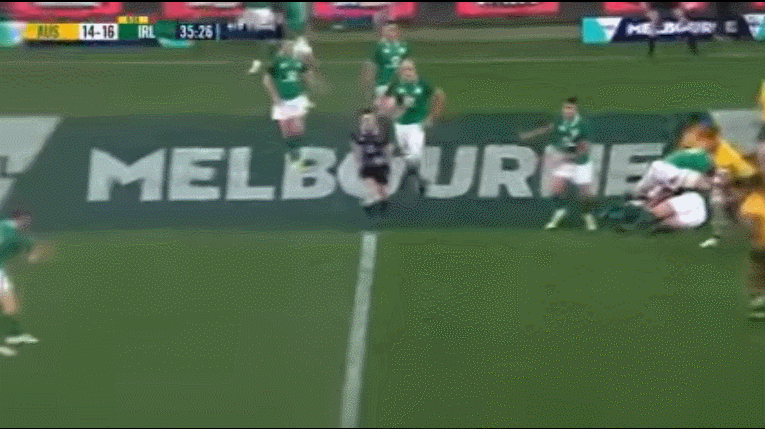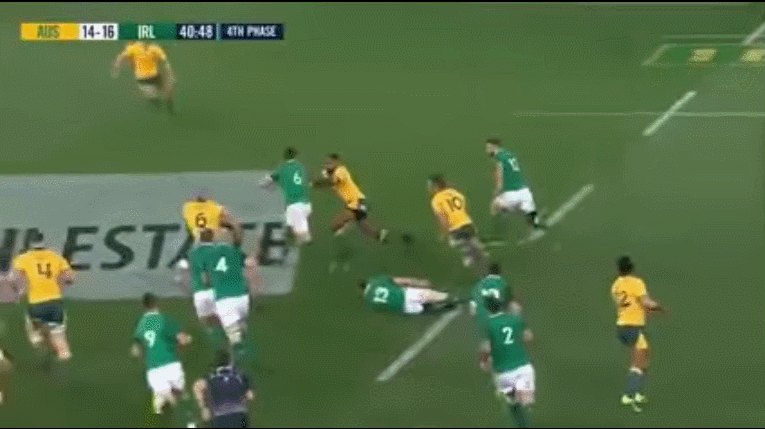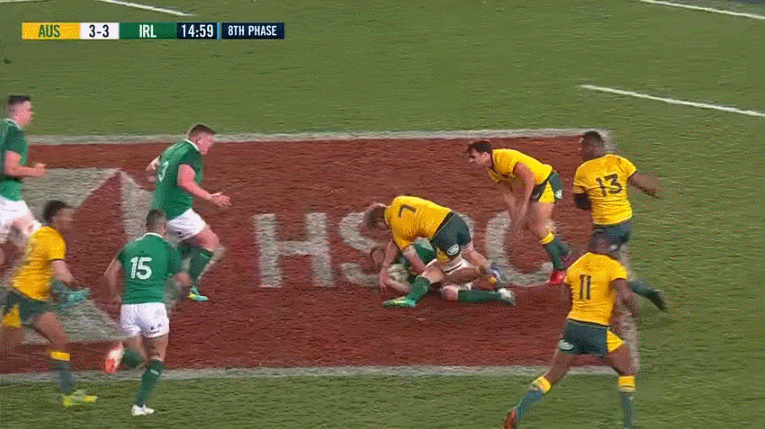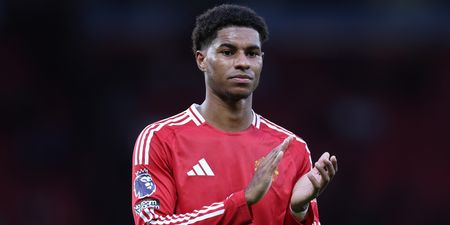“What an effort! I’ve never seen that before,” former Wallaby full-back Greg Martin said after Tadhg Furlong left the second Test in Melbourne with the most run metres of any Irish player.
Furlong walked off the AAMI Park pitch after 72 minutes with 43 metres from 13 carries and further solidified his reputation as one of the best tighthead props in world rugby with a man of the match performance.
His second-half break and attempted skip pass to substitute wing Jordan Larmour demonstrated Furlong’s all-round skillset and a marked development from where he was just two years ago when he was backing up Nathan White in the Six Nations.
Stuart Lancaster arrived at Leinster that summer and gave Furlong the confidence that not only could he make the Ireland team, but that he could play on the British & Lions tour of New Zealand, a bold call for a player that hadn’t started a single Six Nations game in the previous campaign.
“I think the real moment, the focus for me this year, was when Stuart Lancaster came in to Leinster,” Furlong reflected last summer.
“He obviously hadn’t worked with a lot of the players there before.
“And when we sat down he said ‘from what I’ve seen you can really try to push on and aim to be a Lion this year’.
“At first I thought ‘jeez man, what are you saying?!’.
“You probably don’t see yourself in that picture. But he backed me, gave me a focus and a good drive towards it.”
Furlong impressed mightily in the November internationals in the winter that followed, particularly in the loss to New Zealand at Lansdowne road, and he then went onto start all five Six Nations matches the following year as well as all three Tests on the Lions tour.
He followed up his breakout campaign with a historic second season with Ireland and Leinster where he won PRO14, Champions Cup and Grand Slam titles.
He was given greater ball handling responsibilities in both the Leinster and Ireland attacking structures and his pass to Bundee Aki in the lead up to CJ Stander’s try at Twickenham further signified his progression as a passer, but also the capabilities of what Ireland can do in attack with a player of his skill level.
Last month’s series win in Australia further highlighted Furlong’s clear importance to the Irish team and here we look at some clips analysing some of the most telling contributions from the Leinster prop over the course of the Wallabies series.
Ball running
We’ve known Furlong’s ability as a ball runner for sometime now and his blatant disregard of Owen Franks, Brodie Retallick and Kieran Read against the All Blacks in the 2016 November internationals was the punctuation mark on an outstanding end of year series for the 25-year-old.
Furlong runs with deceptive pace and tremendous power but he’s shown an increasing tendency over the last year to look for the next pass once the bump or break has been made.
Here we can see him run a great unders line towards the frame of the post with Rob Herring dropping under Johnny Sexton to hold Tom Robertson and Sila Latu in the Australian defensive line. CJ Stander runs a short decoy line and engages Rob Simmons allowing Furlong a direct shot at inside centre Kurtley Beale.
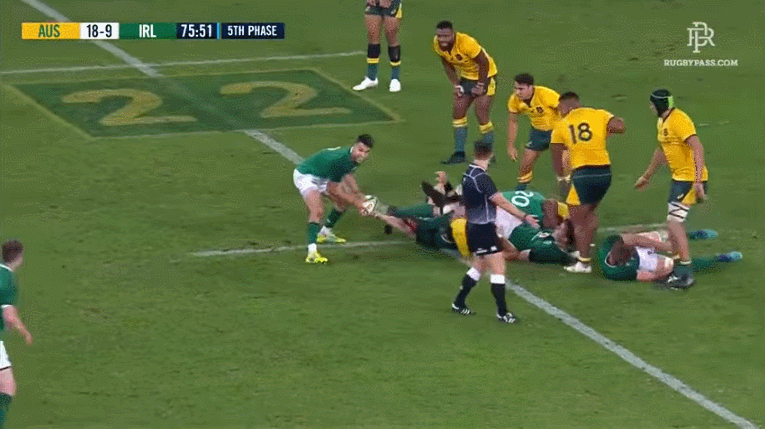
It’s a perfect play by Ireland as Sexton isolates Beale with a one-on-one situation with one of Ireland’s strongest ball carriers, but Furlong ultimately turns a good gain into a great play.
He takes the initial contact from Beale in the tackle, keeps his legs driving and then keeps Wallabies captain Michael Hooper at bay with a fend before offloading the ball to Bundee Aki who takes the ball up to the five metre line.
Ireland later conceded a penalty after some dissent from Conor Murray near the tryline but it serves as a great example of Furlong’s power, mobility and his desire to keep the play alive.
In the second Test we see him again run that same unders line back towards the play but this time he avoids the contact by slipping past Caleb Timu and Marika Koroibete who makes the wrong read on Robbie Henshaw.
Furlong then shows great acceleration to make his way towards the 22 where he shrugs off the challenge of a covering Dan Haylett-Petty, moves the ball from his left hand to his right and then steps across before attempting a skip pass to hit a striding Jordan Larmour.
Bernard Foley jumps up to break up the play but Furlong then shows great reactions to reclaim the ball and establish a great position inside the Wallabies 22.
Furlong has shown dominant power in the carry throughout his time at Leinster but he did a great job in this series of showing that he has an intention to create for his teammates after the initial bust has been made.
He takes good lines, has great hands and his eyes are increasingly fixated on extending the play.
Between Furlong, second-row James Ryan and potentially Tadhg Beirne, Ireland now have a tight five with some genuine handling skills and playmaking ability.
Clean outs
Ireland averaged 61.6% possession in five Six Nations matches and maintaining possession is a big point of emphasis for head coach Joe Schmidt.
Ireland averaged 55.6% possession for the series as they did a great job of minimising Australia’s ball as well doing a decent job of managing the threat of David Pocock and Michael Hooper at the breakdown.
Pocock still forced crucial turnovers during the series but Ireland were effective in committing numbers to the ruck area and ensuring that they maintained possession.
Australia head coach Michael Cheika highlighted Ireland’s tendency to latch onto the ball carrier in the tackle after the loss in Melbourne, but for Furlong in particular, there were a number of rucks he just hit with speed and force that really demonstrated what a player with his sort athleticism can do at the ruck.
Ireland full-back Rob Kearney described the clean out above as ‘one of the best’ he’s seen in professional rugby. Furlong tracks the run of Henshaw, identifies Pocock hovering around the ball carrier and accelerates before blasting him out of contention for the ball with a powerful clean-out.
Similarly in the third Test we can again see Furlong identify the threat of Michael Hooper after a Robbie Henshaw carry, and although the flanker ultimately went off with a hamstring injury after the ruck, it’s a great initial clean out even if he was probably lucky to avoid a penalty for going off his feet.
Ireland won 11 scrums from 14 on the tour and it’s still an area that Furlong can improve in which he should given more experience and time.
At 25, he’s already well ahead of the curve and should continue to improve as a scrummager over the course of the next decade, but some aspects of the game he already has figured out.
He he hits rucks at pace, he runs great lines, he can offload the ball and he has great instincts.
Here we can see Furlong and Murray do an outstanding job of recognising that David Pocock and Sila Latu have both committed to the ruck which has forced scrum-half Nick Phipps to step into the defensive line.
Furlong recognises the newfound space and he realigns wide with Devin Toner before wrapping around the ruck and taking a beautiful one hand pass from Conor Murray.
The try gives Ireland the lead and the chance to make it a two score game and is a great example of Furlong’s attacking intelligence to identify the mismatch and use his power, as we also saw with the the Beale case in game one.
Furlong may have established himself as the world’s premier tighthead prop after last year’s Lions tour but this year he has improved as a playmaker, is increasingly developing a greater understanding of the game and is making match altering impacts from a position where not too long ago Ireland were simply looking for somebody to come and in and sure up that side of the scrum.
Furlong is enjoying great success alongside a host of other outstanding young players for Ireland but he was the tourists’ player of the series in Australia and it was a fitting encore to a season full of hits for the man affectionately known as The Jukebox.


